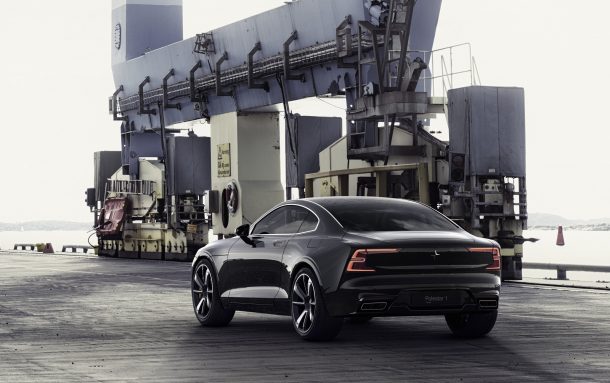Polestar 1 Performance Hybrid Finishes Winter Testing, Heads Southeast for Chinese Debut

Polestar is building the cars Volvo can’t rationalize for its core demographic — high-powered electrics not intended for the general populace. While the brand has tweaked its Swedish autos in the past, Geely’s acquisition of Volvo Cars has seen Polestar evolve into a standalone division with its own unique performance lineup. But its stables are currently empty, at least until Polestar 1 enters into production.
In the interim, the Volvo subsidiary will continue showing the 600-horsepower coupe off to whet the appetites of the global market. That includes the United States because, as of last month, you can preorder one for yourself for $2,500. But production won’t begin in China until next year, and Geely doesn’t want that factory to go to waste. So Polestar will likely trickle out information and multimedia relating to its first model for the entirety of 2018.
This week, we were treated to a video of it attacking a snowy rut during some extreme winter testing inside Sweden’s portion of the Arctic Circle. Interestingly, the car in the video is camouflaged. But we’ve already seen the 2-door sports hybrid uncovered at the Geneva Motor Show — and it just us, or does the Polestar 1 look a little bit like Lincoln persevered with the LS and eventually spawned a coupe variant?
Looks aside, Polestar announced that engineers and test drivers are pleased with the models cold weather performance. And we mean cold. According to the Volvo subsidiary, the Polestar 1 undertook a two-week shakedown in temperatures around -28 degrees Celsius (-18 °F).
The intent was to ensure driving dynamics were up to par in some of the crummiest climates imaginable. But, since the plug-in hybrid also boasts an impressive 93-mile battery range, Polestar also wanted to make sure the arctic didn’t sully the vehicle’s powertrain or energy storage — which can be an issue for EVs.
“Our test drivers have given us some enthusiastic feedback on the handling and dynamics especially,” said Thomas Ingenlath, chief executive for Polestar. “Besides being very happy with the balance of the chassis, they are particularly excited about the torque vectoring. We are now very confident about how this enhances the Polestar 1’s cornering responsiveness and accuracy. This is a driver’s car. We have now passed a major milestone in the development of the Polestar 1, and prototype testing continues throughout 2018.”
The Polestar 1’s torque vectoring system uses two rear electric motors with individual planetary gear sets. All in, the powertrain is good for a claimed 600 horsepower and 737 foot-pounds of torque. It sounds like a potent recipe and we’re eager to learn all we can about it.
While testing continues in Europe, the brand will show off the performance hybrid at the Beijing Auto Show from April 25th through May 4th. We’re hoping additional details leak from its Chinese debut. Sales commence in China, United States, Canada, and most of Europe in 2020.
[Images: Polestar]

A staunch consumer advocate tracking industry trends and regulation. Before joining TTAC, Matt spent a decade working for marketing and research firms based in NYC. Clients included several of the world’s largest automakers, global tire brands, and aftermarket part suppliers. Dissatisfied with the corporate world and resentful of having to wear suits everyday, he pivoted to writing about cars. Since then, that man has become an ardent supporter of the right-to-repair movement, been interviewed on the auto industry by national radio broadcasts, driven more rental cars than anyone ever should, participated in amateur rallying events, and received the requisite minimum training as sanctioned by the SCCA. Handy with a wrench, Matt grew up surrounded by Detroit auto workers and managed to get a pizza delivery job before he was legally eligible. He later found himself driving box trucks through Manhattan, guaranteeing future sympathy for actual truckers. He continues to conduct research pertaining to the automotive sector as an independent contractor and has since moved back to his native Michigan, closer to where the cars are born. A contrarian, Matt claims to prefer understeer — stating that front and all-wheel drive vehicles cater best to his driving style.
More by Matt Posky
Latest Car Reviews
Read moreLatest Product Reviews
Read moreRecent Comments
- Formula m For the gas versions I like the Honda CRV. Haven’t driven the hybrids yet.
- SCE to AUX All that lift makes for an easy rollover of your $70k truck.
- SCE to AUX My son cross-shopped the RAV4 and Model Y, then bought the Y. To their surprise, they hated the RAV4.
- SCE to AUX I'm already driving the cheap EV (19 Ioniq EV).$30k MSRP in late 2018, $23k after subsidy at lease (no tax hassle)$549/year insurance$40 in electricity to drive 1000 miles/month66k miles, no range lossAffordable 16" tiresVirtually no maintenance expensesHyundai (for example) has dramatically cut prices on their EVs, so you can get a 361-mile Ioniq 6 in the high 30s right now.But ask me if I'd go to the Subaru brand if one was affordable, and the answer is no.
- David Murilee Martin, These Toyota Vans were absolute garbage. As the labor even basic service cost 400% as much as servicing a VW Vanagon or American minivan. A skilled Toyota tech would take about 2.5 hours just to change the air cleaner. Also they also broke often, as they overheated and warped the engine and boiled the automatic transmission...







































Comments
Join the conversation
This car looks like rebadged Volvo. What's the point?
Forgive me, but when my eyes locked on the word "Polestar"....... well, you know what I thought of........